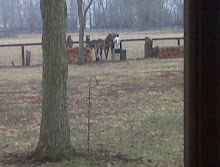Flashpoint breezed 3F in :37 the day before his fantastic triumph over Travelin Man in the Grade 2 7F Hutcheson Stakes at Gulfstream this weekend. I love this move, babe.
Copying the practices of legendary trainer Carl Nafzger
http://horsetrainingscience.blogspot.com/2010/10/nafzgers-secret-with-unbridled.html
with a blowout 24 hours pre-race instead of simply following the pack of supertrainers like Pletcher who allow their charges to go a full week prior to a race with no speedwork.
Now, here is where all horsemen chime in with the ol’ standby: ‘Horses are different, some can take more work than others, we never condition each horse the same.’ Bull. Trainers do condition all horses the same (see below) and each sound horse responds to exercise in the same manner. For instance, all horses have spleens, and all equine spleens work identically – that is they store red blood cells and inject them into the bloodstream upon the onset of extreme stress (i.e. sprinting 3F in :37 or blasting out of the starting gate).

(Click pic to enlarge. Two drops of blood – one of the left that is full of oxygen and one on the right that is de-oxygenated. Which kind do you want coursing through your horse during the first quarter in :23?)
So, when the gate opens all of our colts in the Hutcheson experience splenic contraction and 30% additional red blood cells are injected into the bloodstream. Here is where many bleed in the lungs, as the higher blood volume can overwhelm lung tissues that are unaccustomed to such stress, but that is a topic for another time. More importantly, every horse in the field has a spleen full of blood that is 5-7 days old, less one big exception.
Flashpoint: he who emptied and filled his spleen with fresh RBCs just 32 hours ago.
When blood cells lie sequestered within the spleen they become old, sticky, misshapen, and generally less able to transport oxygen to muscles – which is the key mechanism behind stamina. Fast-forward 60 seconds into the race and you have Flashpoint and Travelin Man side by side, at which point Travelin Man starts Travelin Backwards while Flashpoint cruises to a big win.
In January each raced at 6F with the Pletcher horse carding a huge 106 Beyer compared to Dutrow’s colt with a respectable 91. Pletcher spends Jan and Feb with cookie cutter 4F works while Dutrow throws in a 6F, some 5F’s, and the aforementioned 3F blowout. Yet all the racing rags will conclude that Travelin Man is a sprinter – nothing can be done about it. Nature (pedigree) finished its job 3 years ago, now you can Nurture (condition) for more endurance – or you can simply play the cards you are dealt. In this case, Dutrow traded in a few of those cards more astutely than did Pletcher.
Anyway, yesterday’s PPs for the Hutcheson gives us a prime example of how all trainers condition their horses in the same exact manner: conditioning to me defined as – how FAR, how FAST, and how FREQUENTLY they breeze and/or gallop. Here is a screen grab of the PPs in question (click to enlarge).

Travelin Man and Razmataz are conveniently placed side by side in this attachment. We can see each debuted this year at GP with 6F efforts. Then comes the requisite 14 days off after a race, Dutrow does this too (likely Lasix related says Kenny McPeek), and back to the 4F every 7 days breeze schedule.
Take this data, hold on to it, and watch Uncle Mo follow the precisely same regimen. To be fair, all I have is DRF published data, Pletcher and others could certainly do more behind the scenes, but I doubt it based on what I have personally witnessed on the backside with my stopwatch.
4F works accomplish nothing in the way of stamina in horses of this caliber. The first 40 seconds of such an effort is mostly anaerobic (without oxygen) work – so this doesn’t count in developing endurance. What you are left with in these 4F breezes is about 10 seconds of stamina building exercise, whereas Dutrow throwing in a 6F just a week ago for Flashpoint, accomplished 300% more endurance-specific work. And before that he was popping a few 5F moves while Travelin Man was stuck at 4F.
We have several hundred horses today that can run 8F in 1:36, but none that can get 10F in 2:00. In America we rightfully train for speed because that is how our dirt races are strategically run – but we ignore stamina in the process – and we don’t have to do so.
Uhoh, I got carried away and forgot about the ‘drug cheat’ part of this post.
Do I really need to elaborate? Of course Dutrow is a drug cheat, his record speaks for itself. He won’t deny it, and I am no Pollyanna – most likely all the thoroughbred legends of the past had some drugs in them to accomplish such great things – but they were also conditioned quite aggressively to match.









